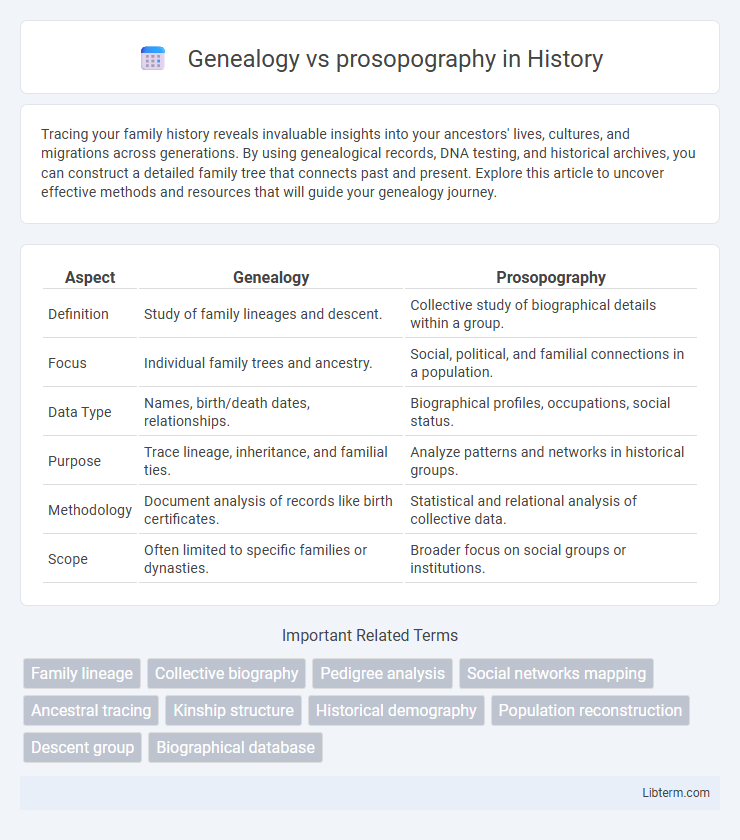Tracing your family history reveals invaluable insights into your ancestors' lives, cultures, and migrations across generations. By using genealogical records, DNA testing, and historical archives, you can construct a detailed family tree that connects past and present. Explore this article to uncover effective methods and resources that will guide your genealogy journey.
Table of Comparison
| Aspect | Genealogy | Prosopography |
|---|---|---|
| Definition | Study of family lineages and descent. | Collective study of biographical details within a group. |
| Focus | Individual family trees and ancestry. | Social, political, and familial connections in a population. |
| Data Type | Names, birth/death dates, relationships. | Biographical profiles, occupations, social status. |
| Purpose | Trace lineage, inheritance, and familial ties. | Analyze patterns and networks in historical groups. |
| Methodology | Document analysis of records like birth certificates. | Statistical and relational analysis of collective data. |
| Scope | Often limited to specific families or dynasties. | Broader focus on social groups or institutions. |
Introduction to Genealogy and Prosopography
Genealogy traces individual family lineages and relationships through historical records, emphasizing personal ancestry and heritage connections. Prosopography studies collective biographies to analyze social structures and historical populations by examining patterns among groups rather than single individuals. Both methods utilize archival data but differ in scope: genealogy focuses on specific descent lines, while prosopography explores broader social networks and characteristics.
Defining Genealogy: Tracing Lineages
Genealogy involves tracing individual lineages by documenting family relationships, inherited traits, and ancestral connections across generations. It emphasizes personal descent, birth, marriage, and death records to construct detailed family trees and understand hereditary patterns. Unlike prosopography, which studies collective biographies to analyze social structures, genealogy focuses on specific familial lines and their historical continuity.
Understanding Prosopography: Collective Biography
Prosopography analyzes collective biographies by examining common characteristics of historical groups to understand social structures and relationships. Unlike genealogy, which traces individual lineage and family trees, prosopography focuses on aggregating data such as occupations, social status, and affiliations to identify patterns within populations. This method provides insights into the dynamics of communities, political networks, and cultural trends over time.
Methodological Differences
Genealogy investigates individual lineages by tracing biological or familial relationships to construct family trees, using vital records and personal documents as primary sources. Prosopography analyzes collective biographies to identify social patterns and relationships within defined groups, often employing statistical analysis and prosopographic databases. The methodological difference lies in genealogy's focus on singular ancestry versus prosopography's emphasis on group dynamics and social structures.
Sources and Data Collection
Genealogy relies heavily on vital records such as birth, marriage, and death certificates, alongside census data, church registers, and personal documents to establish family lineages and relationships. Prosopography aggregates a broader spectrum of data, collecting information from historical texts, administrative records, legal documents, and inscriptions to analyze collective biographies within specific groups or populations. While genealogy focuses on individual familial connections, prosopography emphasizes patterns and social structures, requiring extensive cross-referencing from diverse and often fragmentary sources.
Purposes and Applications
Genealogy primarily traces individual family lineages to establish hereditary connections and inheritance rights, aiding in personal identity and legal claims. Prosopography analyzes collective biographical data of groups to uncover social patterns, relationships, and historical trends, often used in academic research and social history. While genealogy emphasizes individual ancestry, prosopography focuses on social networks and shared characteristics within specific populations.
Challenges and Limitations
Genealogy faces challenges such as incomplete historical records, inaccuracies in oral traditions, and difficulties in verifying lineage over multiple generations. Prosopography encounters limitations in data reliability, as it often relies on fragmented sources that can lead to biased or incomplete group profiles. Both methods struggle with contextual interpretation, where missing socio-cultural information may hinder a comprehensive understanding of ancestral connections or collective biographies.
Genealogy in Historical Research
Genealogy in historical research involves tracing lineage and family histories to uncover social, economic, and cultural connections across generations. It relies heavily on primary sources such as birth, marriage, and death records, which provide granular data essential for constructing detailed family trees and understanding hereditary patterns. Unlike prosopography, which analyzes collective biographies of groups, genealogy offers a personalized approach to historical inquiry by illuminating individual and familial contexts within broader historical narratives.
Prosopography in Social Analysis
Prosopography systematically studies the collective characteristics of historical groups by analyzing common backgrounds, relationships, and social networks to uncover patterns within societies. Unlike genealogy, which emphasizes individual family lineages, prosopography provides essential data for social analysis by revealing the structures and dynamics of past communities through aggregated biographical information. This method facilitates understanding of social hierarchies, political affiliations, and cultural trends in historical research.
Conclusion: Complementary Approaches
Genealogy and prosopography serve distinct yet complementary purposes in historical research, with genealogy tracing individual family lineages and prosopography analyzing collective biographical patterns within specific groups. Integrating both approaches enriches the understanding of social structures, revealing connections between personal ancestry and broader societal trends. Employing these methods together enhances the depth and scope of historical analysis, bridging micro-level personal histories with macro-level social dynamics.
Genealogy Infographic

 libterm.com
libterm.com